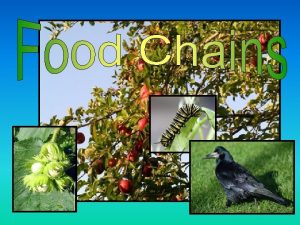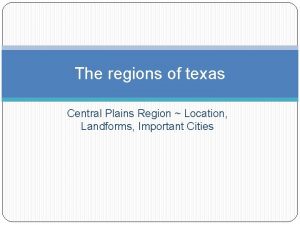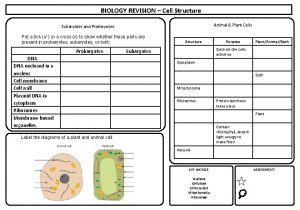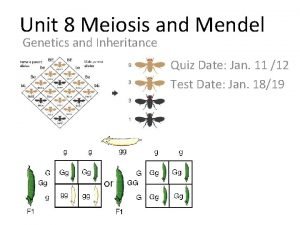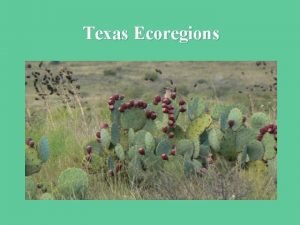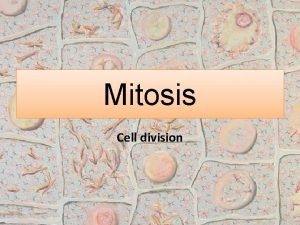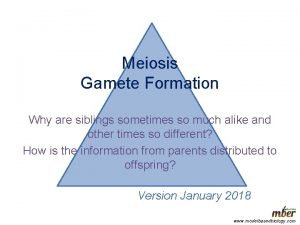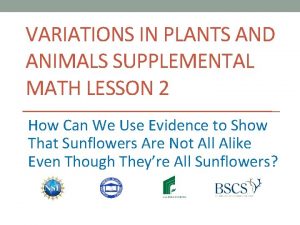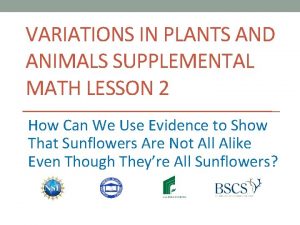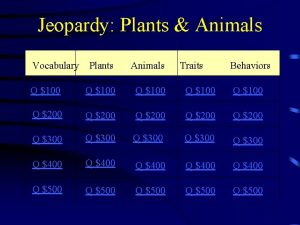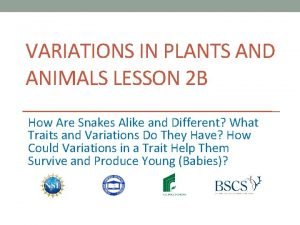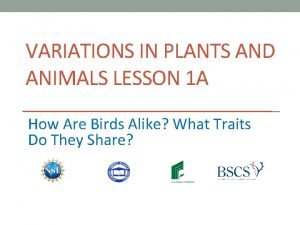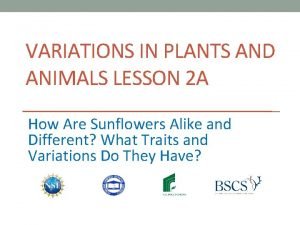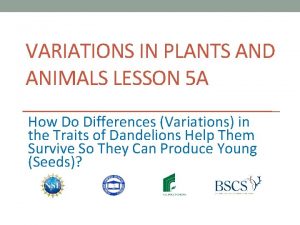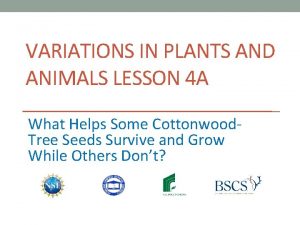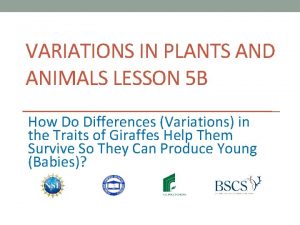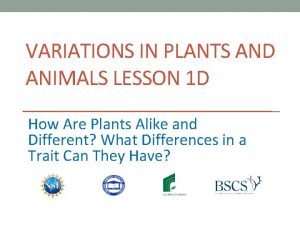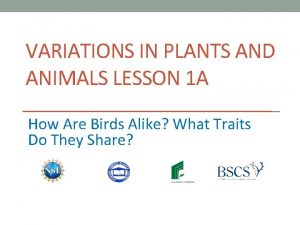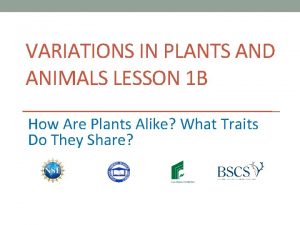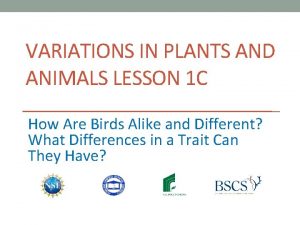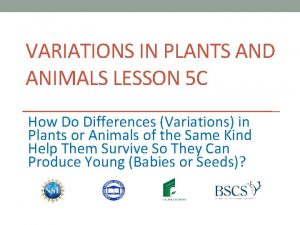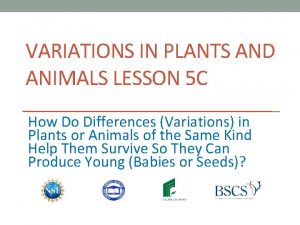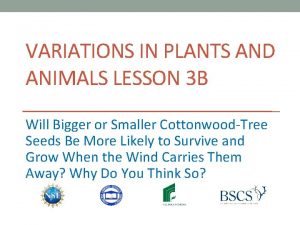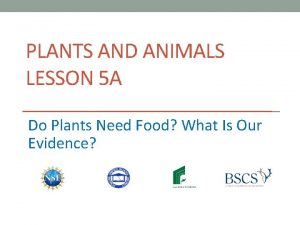VARIATIONS IN PLANTS AND ANIMALS SUPPLEMENTAL MATH LESSON





















- Slides: 21

VARIATIONS IN PLANTS AND ANIMALS SUPPLEMENTAL MATH LESSON 1 How Can We Use Evidence to Show That Sunflowers Are Not All Alike Even Though They’re All Sunflowers?

How Are Sunflowers Alike and Different? Photo courtesy of An. Ro 0002/Wikimedia Commons Photo courtesy of Pixabay. com

Showing Variations in Sunflower Traits • How could we show variations in sunflower traits in a more scientific way? • What might a scientist do to learn more about the differences or variations in sunflower traits? Photo courtesy of An. Ro 0002/Wikimedia Commons Photo courtesy of Pixabay. com

Today’s Focus Question How can we use evidence to show that sunflowers are not all alike even though they’re all sunflowers?

Sunflower Seeds Photo courtesy of Pixabay. com

How Are Sunflower Seeds Alike and Different? • Pour the bag of sunflower seeds on a sheet of notebook paper and look at them closely. • How are the seeds alike? How are they different? • Share your observations with your partner. Then write them in your science notebook. Photo courtesy of Pixabay. com

Sunflower Seeds How could you show that some seeds are bigger and some are smaller? Photo courtesy of Pixabay. com

Ways to Gather Evidence • Comparing and measuring traits are two ways we can gather evidence of variations. • We can be more accurate if we measure a trait. Photo courtesy of Pixabay. com

How Could We Compare These Plants? Photos courtesy of Stock. Adobe. com

Measure Your Sunflowers Pairs: 1. Use your measuring tool to measure the height of your sunflower plant (the length of the stem). 2. Measure at least twice to make sure your measurement is correct. 3. Record your measurement on your handout under the correct column. Example: If you’re measuring Sunflower 1, record your data in the column that says “Sunflower 1. ”

Let’s Record Our Sunflower Data! Sunflower 1 Sunflower 2 Sunflower 3 How tall is the plant? How long is the leaf? How wide is the flower?

Are These Sunflowers Real? Photos courtesy of Stock. Adobe. com

Why Do Scientists Use Models? Photos courtesy of Stock. Adobe. com

Why Do Scientists Use Models? • Models represent real things, but they aren’t the real things. • Scientists use models to learn about things that are too difficult or dangerous to study up close, or maybe because the real thing is too hard to find. • Sometimes an object is too far away to study, like a planet. Or it might be too small, like a drop of water. • We used a sunflower model because real sunflowers would be hard to find and would wilt.

Our Sunflower Measurements • What do you notice about our measurements? • What do our measurements tell us about the stem-length (height) trait of the sunflower plants? Photo courtesy of Stock. Adobe. com

Our Sunflower Measurements Complete these sentences: • The height of Sunflower 1 is [more than/less than] the height of Sunflower 2. • The height of Sunflower 2 is [more than/less than] the height of Sunflower 3. • The height of Sunflower 3 is [more than/less than] the height of Sunflower 1. Photo courtesy of Stock. Adobe. com

Which Plant Is More Likely to Survive? • Do you think that variations in the stem-length (height) trait give a sunflower a better chance of surviving in its environment? • Will a taller sunflower be more likely to survive than a shorter one? Why or why not? Photo courtesy of Stock. Adobe. com

Variations in Sunflower Seeds 1. Think of a trait you observed in the sunflower seeds. 2. Then draw two variations of that trait in your science notebook. 3. Make sure to label the trait and the variations. Photo courtesy of Pixabay. com

Let’s Summarize! Our focus question: How can we use evidence to show that sunflowers are not all alike even though they’re all sunflowers? • How did we show that sunflowers aren’t exactly alike even though they’re all sunflowers? What evidence did we use?

Key Science Ideas • Sunflowers share many traits, like seeds and stems. But they aren’t exactly alike. • Sunflowers also have many differences in their traits, like the size of their seeds and the height (or length) of their stems. • These differences are called variations.

Next Time In our next lesson, we’ll construct a bar graph to help us compare and describe the data (evidence) we collected on variations in sunflower traits.
 Are bears producers or consumers
Are bears producers or consumers Parasitic food chain
Parasitic food chain Carnivore
Carnivore Pictorial models of geometric figures with no labels
Pictorial models of geometric figures with no labels Blank graphic organizers for staar
Blank graphic organizers for staar Site of meiosis in plants and animals
Site of meiosis in plants and animals A keystone
A keystone Cloroplasto
Cloroplasto Venn diagram asexual and sexual reproduction
Venn diagram asexual and sexual reproduction Frogs in the temperate deciduous forest
Frogs in the temperate deciduous forest Every living plants and animals must have
Every living plants and animals must have Importance of plants
Importance of plants Grade 5 natural science term 1
Grade 5 natural science term 1 Central plains industries
Central plains industries Grassland biome animals and plants
Grassland biome animals and plants How many regions in texas
How many regions in texas Science class five
Science class five Animal biology revision
Animal biology revision Chromosome number of human
Chromosome number of human 10 ecoregions of texas
10 ecoregions of texas Differences between mitosis in plants and animals
Differences between mitosis in plants and animals Lucy and maria twins
Lucy and maria twins










